

The History, Science and Speed Tricks of Drinking Bird Toys

While most references credit Dr. Miles V. Sullivan as the inventor of the drinking bird because he patented it in 1946, the idea of using heat-driven oscillating liquids to repeatedly tip small mechanisms has been around for well over a century. The concept made its first appearance as a toy from China named the Insatiable Birdie between 1910 to 1930. Still earlier examples of the basic concept can be found in the A. and A. Iske brothers' 1881 patent for a circular heat engine that used the same principle to make a wheel rotate...

Sketch of Iske engine concept
...and a blown glass rocker that worked by solar power. The following is a sketch from an 1887 Scientific American article.
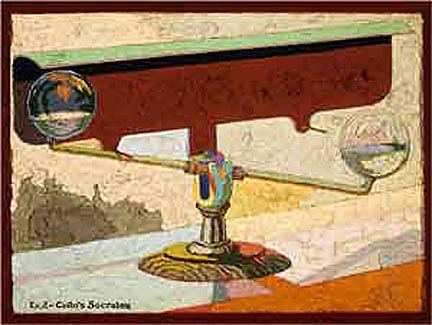
The biggest difference is that neither of these last two examples used water to cool one end of the devices.
Whatever their origin, drinking birds were an instant hit when they first entered mass marketing in the mid 1940s and to this day are one of the most popular novelty toys ever created. It's easy to understand why. In their simplicity and comical appearance it's hard for anyone to resist their charm.
Most birds are red or blue and free standing. However, there are also much rarer birds with yellow, purple and green liquid. There is even one that hangs on the side of a glass instead of standing on its own base. Regardless of the liquid's color all drinking birds have red heads.
So... how do they work? In the following images all of the hardware has been removed from a drinking bird to help see the actual working mechanism:

Drinking birds consist of a glass tube with a bulb at each end. The tube extends almost to the bottom of the lower bulb. After having a rough vacuum drawn to remove air they were originally filled with trichloromonofluoromethane, a common air conditioning working fluid that boils at room temperature. This chemical turned out to damage the earth's ozone layer and has been banned. All current drinking birds use dichloromethane, also called methylene chloride, a much safer common solvent with similar properties. When the head is dry the temperature of the methylene chloride liquid and gas are the same and the liquid settles to the bottom. The bird stands upright, waiting for a bit of moisture on the upper sphere to start the show.
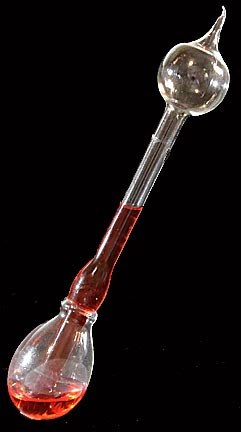
Normally there is a fuzzy coating on the upper bulb that holds water and as it evaporates, cools the top. To start the bird the top is wetted, the water evaporates cooling the top. As the methylene chloride gas in the top cools it contracts and condenses reducing the pressure. Because of the small temperture difference there is very little contraction. Most of the pressure change is from condensation. Gas trapped above the liquid in the bottom bulb expands to maintain equilibrium. As it does it pushes down on the liquid forcing it up the tube. (It's a matter of personal preference whether readers want to think of the liquid as being sucked up the tube by the lower pressure in the upper bulb or pushed up the tube by the greater pressure in the lower bulb. It all depends on which pressure is chosen as the reference.) Liquid rises in the tube making the bird top heavy so it starts to lean over.

The leaning increases as more liquid goes up the tube until it reaches a critical point near horizontal where the end of the tube in the lower bulb raises above the surface of the liquid. When this happens warm gas from the bottom is pushed through the top of the tube into the upper bulb (red arrow) at the same time that liquid flows back into the bottom bulb (green arrow.) The reason this happens is that while the image above shows the tube horizontal, in fact this happens with the upper bulb slightly higher than the lower one. The gas, being lighter, wants to rise and the liquid, being heavier, drains downward.
This results in the bird once again being bottom heavy so it swings back into its vertical position and starts the process all over again.
One of the remarkable features of drinking birds is that they can function on very small temperature differences. Using an infrared thermometer I measured the difference of the upper bulb and lower bulb temperatures at only 2-degrees F. Calculations suggest it takes 1/2-watt of power to drive a drinking bird. Because of the small temperature difference between the phases of operation its efficiency is very low and only 1/20,000-watt of mechanical power is produced. People have theorised ways to extract this power using magnets and coils and calculated the best that could be done is on the order of 1/1,000,000 watt electrical.
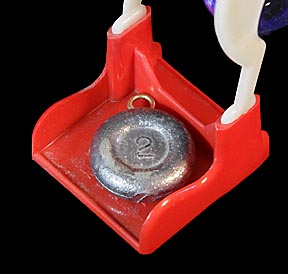
Because the drinking bird's base is light compared to the bird itself, the swinging of the bird's body tends to make it walk. As it does so it can start banging the bottom bulb into the water glass, pivoting left or right or even backing up so its beak no longer touches the water. One way to prevent this is to place a two ounce fishing weight on the base.
Operationally, the only other potential problem is the position of the yoke's blades in the stand's cut-outs. They should be centered, as shown in the following image:

If the blades are too far forward their tops will rub on the plastic and prevent the bird from tipping.
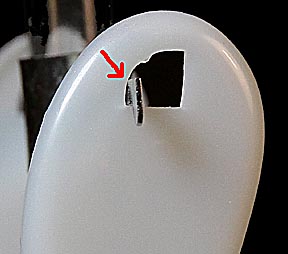
If they're too far back the plastic tab used to keep the bird from tipping over past horizontal will also prevent the bird from working.
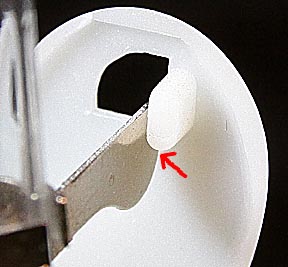
The drinking bird's body is balanced on a thin metal yoke (cyan arrow) crimped around the glass tube between the upper and lower bulbs.
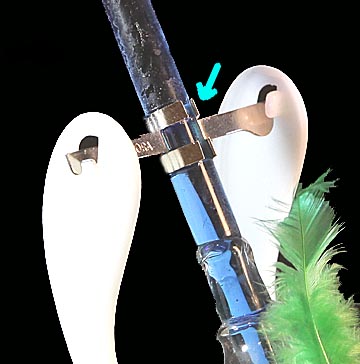
The yoke slides up and down the tube enabling the drinking speed to be adjusted. Sliding it down increases how many times per minute the bird takes a drink because it takes less liquid moving up to tip the bird over. Very quickly a point is reached where the bird never returns to a straight upright position to rock comically back and forth. Instead it only eases back to a 45-degree incline before starting to dip down. Personally, I find this a bit boring. Sliding the yoke up means more liquid has to rise to tip the bird over so this reduces how many times per minute the bird takes a drink. It also increases how long the bird spends rocking back and forth before starting to tilt downward. Careful adjustment slows the rate at which the bird tilts so that it seems to hang in the air, leaning over with excruciating slowness until it finally reaches the water and suddenly bursts back to life as it suddenly pops upright. Go a little beyond this point and the fulcrum, or tilting point, is so high not enough liquid ever gets high enough to allow to the bird to tilt over and drink. For myself, I prefer the yoke to be set so the bird drinks every 15 seconds. This provides enough action to keep it interesting, a dramatic pause before it finally reaches the water and an entertaining amount of rocking back and forth once it does.
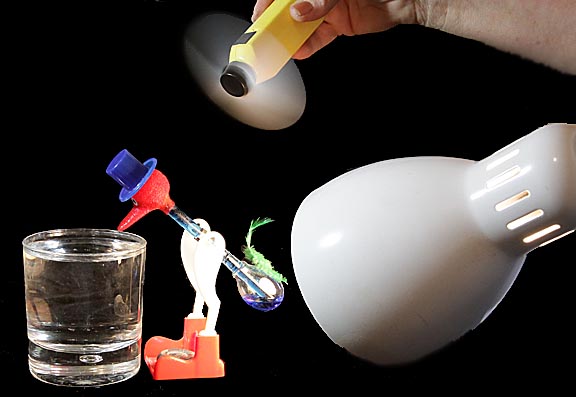
Besides lowering the yoke to increase speed, the time per "drink" can be decreased by shining a hot light at the base to heat its liquid and gas, which increass the pressure in the lower bulb, and using a fan to blow air over the upper bulb, which increases evaporation resulting in lower temperatures and corresponding lower pressures. If a bird is balanced to take a drink every 15 seconds, adding a lamp and fan can reduce this to 8 seconds. Using ice cold water can trim another two off that.
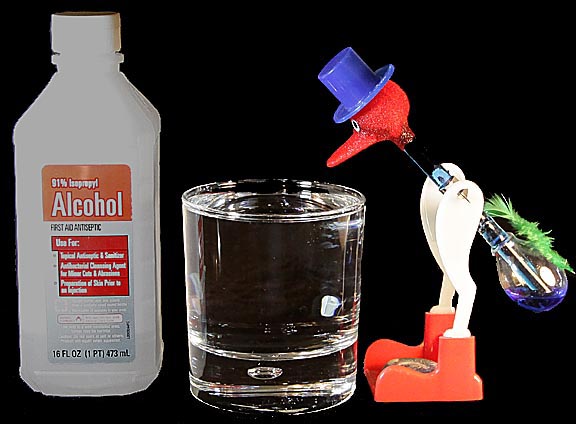
If 91-percent alcohol is used instead of water, its faster evaporation rate creates more cooling. A 15-second bird in water will take a drink every 8 seconds with alcohol.
Taking out all the stops, I used ice cold alcohol, a hot lamp and a fan and got a 15-second bird to take a drink every 2 seconds. I called it "TURBO BIRD." Here's a video of it:
Removing the water glass does not immediately stop a drinking bird from drinking. As long as the head remains damp the bird with continue to tip over. In my low humidity high desert environment a bird will continue to operate for over two hours. In areas with higher humidity, the evaporation rate will be lower and the bird may continue "drinking" for many hours, though at a much slower rate.
The following short video shows all the drinking birds in my collection:
Besides being silly, and therefore fun, drinking birds can serve a practical purpose in eduction. Using the material on this page an excellent science project can be created for students of almost any grade.
Return to my main page to browse over 100 other subjects